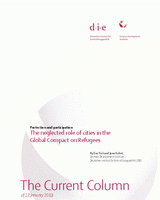Protection and participation
The neglected role of cities in the Global Compact on Refugees
Dick, Eva / Jana KuhntThe Current Column (2019)
Bonn: German Development Institute / Deutsches Institut für Entwicklungspolitik (DIE), (The Current Column of 23 January 2019)
Bonn, 23 January 2019. The commitment of many Italian mayors to taking in refugees in defiance of the uncompromising stance of their Interior Minister Matteo Salvini has attracted a great deal of public attention in recent weeks. At a time when refugee numbers are at a historic high, their actions epitomise the growing importance of cities for the protection and societal participation of displaced persons all over the world. However, the Global Compact on Refugees, adopted by the UN General Assembly in New York on 17 December 2018, shows that this importance still lacks adequate recognition at international level. If a sustainable policy on refugees is to be implemented, therefore, the potential of cities and municipalities has to be given greater acknowledgement and support globally, nationally and locally.
Forced displacement has increased across the world in recent years. As many as 85 per cent of refugees are now living in low- or middle-income countries that are struggling with their own economic and development problems. At the same time, the percentage of those in long-term displacement has risen: in 2017, around two thirds of all refugees had no or very little chance of returning to their home countries for several years or even decades. High-profile examples include the civil war in Syria, which has been raging since 2012, and the Somali refugee crisis, which stretches back to the 1990s. As well as posing challenges to the host societies, the consequences for the refugees themselves – many of whom are young people – are long-term unemployment and lacking prospects of societal participation.
The Global Compact on Refugees is responding to these trends with a major paradigm shift, seeking to improve refugees’ prospects by, in particular, integrating them better into local life and promoting their economic self-reliance. Refugees are to be given greater access to financial services, education systems and labour markets in their host countries. In return, the international community is to undertake to support these countries by providing knowledge and resources. In the future, refugee camps are to be the exception rather than the rule and merely a short-term humanitarian solution.
While the compact acknowledges that refugees are already increasingly finding themselves outside camps, it ignores another spatial dimension almost entirely: the key role of cities as actors and important drivers of integration in displacement situations. Cities are currently home to over half of all refugees and an even higher proportion of internally displaced persons – more than 80 percent. In addition, sizable numbers of (recognised) refugees voluntarily – and often illegally – leave the shelter of the camp to be able to make a living for themselves and their family. Studies also indicate a marked tendency for returnees to (re)settle in urban areas in their home country.
From the refugees’ perspective, the benefits of established cities and municipalities are obvious: unlike the camps, they often allow the refugees to live more autonomous lives with the prospect of social and economic integration. Urban networks also provide informal protection and help with finding a job and a place to live. However, living an urban life “under the radar” of state institutions affords little security and makes people vulnerable. Urban refugees are more often victims of sexual assault, exploitation and verbal and physical abuse. This is especially true in countries that do not officially allow them to settle outside the camps. Here, within cities they have virtually no chance of accessing public education or healthcare and only limited scope for calling on international aid and protection. In addition, unregistered refugees are often left to the mercy of local authorities.
To develop lasting solutions beyond refugee camps, the key role played by cities and municipalities must be recognised and supported. This needs to be done at several levels: at international level, by involving mayors and networks of cities (as mentioned in the Compact) more closely in global policymaking. Existing UNHCR concepts must also be tailored more specifically to urban requirements. Moreover, this applies to bi- and multilateral development cooperation, whose measures should also consider the needs of urban refugees and migrants. At national level, cities and municipalities need to be given more powers to make policy and financial decisions and ensure that urban refugees are afforded political and legal recognition. Last but not least, the task at local level will be to incorporate refugees more effectively into existing urban development and budget plans. City governments, town councils and locals also need to be made more aware of the potential positive impact of integrating refugees into the host economy and society.


